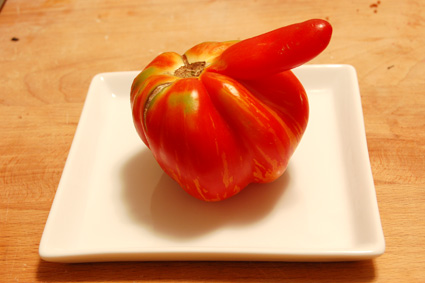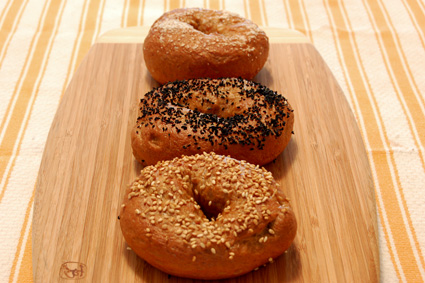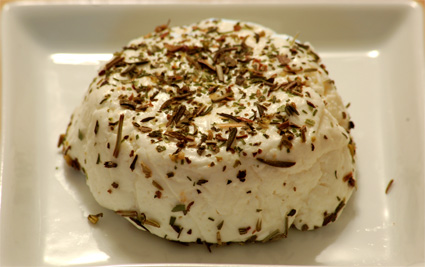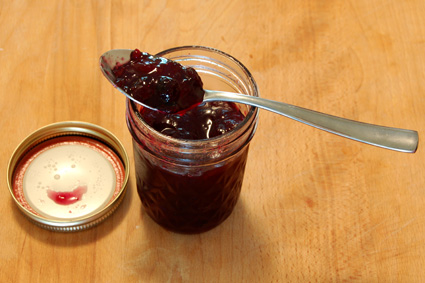Lewisburg.
Less than a week in, the sourdough starter has taken up residency in the refrigerator; twice-daily feedings quickly outstrip all but the most ambitious baking schedules. Even in the past week I've baked two loaves of bread and made a big batch of pancakes. Two people just can't eat that much. Even when it looks this fine:
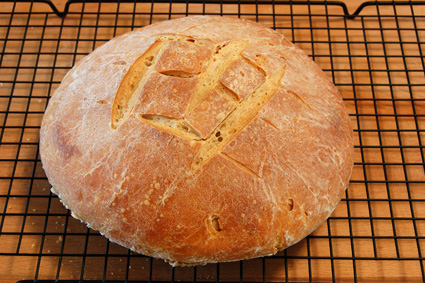
The crumb's dense, soft and chewy; the taste is intensely sourdough. It's great simply toasted (or not) and spread with butter. But it takes more attention and effort than I'd like to give it: a wet, near-batter dough sits overnight; in the morning, it requires kneading with additional flour; after several hours of proofing, it's time to shape, followed by several more hours of proofing before it's ready to bake. I'd originally tried it using the no-knead recipe, but that only yielded an uninflated, gluten-free mass of dough. The sourdough, it seems, prevents that lazy method of gluten formation that I've become such a fan of.
This wasn't such an issue with sourdough pancakes, however. Normally a pancake recipe that's allowed an overnight rest to develop bubbles from instant yeast, I'd decided to give it a shot with the sourdough starter. There was no recipe to follow for this one, so I just had to wing it.
Pro: They were pancakes with real sourdough flavor.
Con: They weren't so much pancakes as crepes.
The difficulty, it seems, is that sourdough just doesn't produce the same vigorous bubbling that commercially available yeasts do. So, when the yeasts were supposed to metabolize the available sugars faster and faster as the pancakes cooked on the griddle, they just weren't up to the task. Hence the sourdough crepes. Sourdough blueberry crepes, actually, which was definitely messier than expected, but worth the cleanup.
1And, speaking of irritating kitchen cleanups, I've also finished my first batches of sausage since moving to Pennsylvania. Nothing quite like a sinkful of bowls, grinders, and other items crusted with bits of raw meat to make one wonder if the effort's really worth it.
2The first sausage, at Sharon's request, was another batch of the "chicken marsala" sausage that had been such a hit before. It's chicken, with sauteed shiitake mushrooms, roasted garlic, onions and marsala wine, loaded with enough fat to keep it all moist through the cooking. It's great with some relatively simple starches - fresh egg pasta or spätzle would be a fine choice - and whatever green vegetables are in season. Though, as an accompaniment, it's hard to go wrong with some garlicky spinach, just barely wilted.
The other sausage, since I had some extra meat, was a chicken variation on Mexican chorizo. It's normal to have it loose, rather than stuffed in casings, and I couldn't complain about not having to clean the sausage stuffer twice. A pair of leg quarters from an older bird - hence liberally studded with fat - plus salt and a range of spices, run through the grinder and moistened with a little tequila and vinegar. It's the sort of sausage I could make on a whim one night.
Toss it in a hot pan with onions and garlic, sear up a few scallops, and add some chopped tomato until just barely softened, and you're ninety percent of the way to a great dinner.
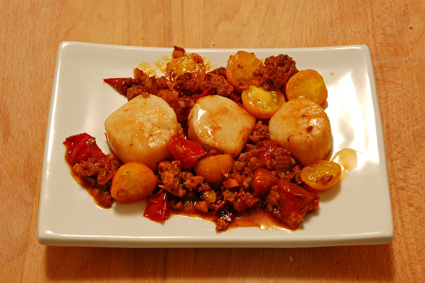
Assuming you don't have a meat grinder, or that it's too much effort to use it and clean it, here's a version using ground meat. Turkey or pork would work equally well, though in all cases it's best to get the fattiest ground meat available. Good sausage is about 30% fat, which not only adds a lot of flavor, but also contributes enough moisture to keep the meat from seeming dry and rubbery if overcooked.
Mexican-style chicken chorizo
Makes approximately one pound of loose sausage
Ingredients
- One pound ground chicken, or ground chicken with added pork fat (30% fat is ideal)
- 8 grams kosher salt, or slightly more than half a tablespoon
- ½ tablespoon ancho chilli powder
- ½ teaspoon paprika
- ½ teaspoon chipotle chilli powder
- ¼ teaspoon ground black pepper
- ¼ teaspoon dried oregano (or ½ teaspoon fresh)
- 1/8 teaspoon cumin
- ½ tablespoon tequila
- ½ tablespoon cider vinegar
Directions
- In a bowl, mix together the meat and spices for about a minute, until thoroughly combined. Add the tequila and cider vinegar, stirring until completely absorbed.
- If desired, cook up a small piece to check the seasonings, and adjust as necessary. Store in the refrigerator and use within a few days or store in the freezer, tightly wrapped in plastic.
* * * * *
1This stands in stark contrast to the one and only time I made blueberry waffles. Delicious, yes, but cleaning caramelized blueberry out of the waffle iron is one of the least enjoyable kitchen tasks I've ever undertaken.
2It is. I wonder the same thing after every batch of homebrew, but it always is.
